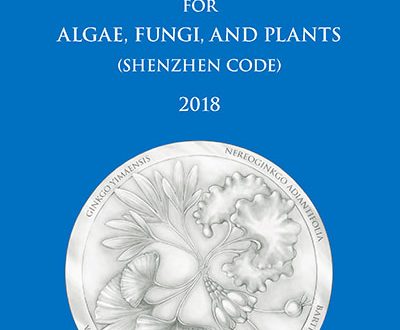The International Code of Nomenclature for algae, fungi, and plants (ICN) is the set of rules and recommendations dealing with the formal botanical names that are given to plants, fungi and a few other groups of organisms, all those “traditionally treated as algae, fungi, or plants”. It was formerly called the International Code of Botanical Nomenclature (ICBN); the name was changed at the International Botanical Congress in Melbourne in July 2011 as part of the Melbourne Code which replaced the Vienna Code of 2005.
The current version of the code is the Shenzhen Code adopted by the International Botanical Congress held in Shenzhen, China, in July 2017. As with previous codes, it took effect as soon as it was ratified by the congress (on 29 July 2017), but the documentation of the code in its final form was not published until 26 June 2018.
The name of the Code is partly capitalized and partly not. The lower-case for “algae, fungi, and plants” indicates that these terms are not formal names of clades, but indicate groups of organisms that were historically known by these names and traditionally studied by phycologists, mycologists, and botanists. This includes blue-green algae (Cyanobacteria); fungi, including chytrids, oomycetes, and slime moulds; photosynthetic protists and taxonomically related non-photosynthetic groups. There are special provisions in the ICN for some of these groups, as there are for fossils.
- The ICN can only be changed by an International Botanical Congress (IBC).
- Each new edition supersedes the earlier editions and is retroactive back to 1753, except where different starting dates are specified.
Best safe and secure cloud storage with password protection
Get Envato Elements, Prime Video, Hotstar and Netflix For Free
Best Money Earning Website 100$ Day
#1 Top ranking article submission website
Good to know:
- The Code has three divisions:
Division I: Principles
Division II: Rules and Recommendations
Division III: Provisions for governance - Each division is subdivided into one or more chapter(s) which are then divided into several sections and then sections into articles.
- Link to Shenzen Code
Preamble of Melbourne Code
1. Biology requires a precise and simple system of nomenclature that is used in all countries, dealing on the one hand with the terms that denote the ranks of taxonomic groups or units, and on the other hand with the scientific names that are applied to the individual taxonomic groups. The purpose of giving a name to a taxonomic group is not to indicate its characters or history, but to supply a means of referring to it and to indicate its taxonomic rank. This Code aims at the provision of a stable method of naming taxonomic groups, avoiding and rejecting the use of names that may cause error or ambiguity or throw science into confusion. Next in importance is the avoidance of the useless creation of names. Other considerations, such as absolute grammatical correctness, regularity or euphony of names, more or less prevailing custom, regard for persons, etc., notwithstanding their undeniable importance, are relatively accessory.
2. Algae, fungi, and plants are the organisms covered by this Code.
3. The Principles form the basis of the system of nomenclature governed by this Code.
4. The detailed provisions are divided into rules, which are set out in the Articles (Art.) (sometimes with clarification in Notes), and Recommendations (Rec.). Examples (Ex.) are added to the rules and recommendations to illustrate them. A Glossary defining terms used in this Code is included.
5. The object of the rules is to put the nomenclature of the past into order and to provide for that of the future; names contrary to a rule cannot be maintained.
6. The Recommendations deal with subsidiary points, their object being to bring about greater uniformity and clarity, especially in future nomenclature; names contrary to a Recommendation cannot, on that account, be rejected, but they are not examples to be followed.
7. The provisions regulating the governance of this Code form its last Division (Div. III).
8. The provisions of this Code apply to all organisms traditionally treated as algae, fungi, or plants, whether fossil or non-fossil, including blue-green algae (Cyanobacteria), chytrids, oomycetes, slime moulds, and photosynthetic protists with their taxonomically related non-photosynthetic groups (but excluding Microsporidia). Provisions for the names of hybrids appear in Appendix I.
9. Names that have been conserved or rejected, suppressed works, and binding decisions are given in Appendices II–VIII.
10. The Appendices form an integral part of this Code, whether published together with, or separately from, the main text.
11. The International Code of Nomenclature for Cultivated Plants is prepared under the authority of the International Commission for the Nomenclature of Cultivated Plants and deals with the use and formation of names applied to special categories of organisms in agriculture, forestry, and horticulture.
12. The only proper reasons for changing a name are either a more profound knowledge of the facts resulting from adequate taxonomic study or the necessity of giving up a nomenclature that is contrary to the rules.
13. In the absence of a relevant rule or where the consequences of rules are doubtful, established custom is followed.
14. This edition of the Code supersedes all previous editions.
(Text: © 2012, IAPT — web-edition: © 2014, Paul van Rijckevorsel (all rights reserved))
Preamble of Shenzen Code
1. Biology requires a precise and simple system of nomenclature that is used in all countries, dealing on the one hand with the terms that denote the ranks of taxonomic groups or units, and on the other hand with the scientific names that are applied to the individual taxonomic groups. The purpose of giving a name to a taxonomic group is not to indicate its characters or history, but to supply a means of referring to it and to indicate its taxonomic rank. This Code aims at the provision of a stable method of naming taxonomic groups, avoiding and rejecting the use of names that may cause error or ambiguity or throw science into confusion. Next in importance is the avoidance of the useless creation of names. Other considerations, such as absolute grammatical correctness, regularity or euphony of names, more or less prevailing custom, regard for persons, etc., notwithstanding their undeniable importance, are relatively accessory.
2. Algae, fungi, and plants are the organisms covered by this Code.
[footnote] In this Code, unless otherwise indicated, the word “organism” applies only to the organisms covered by this Code, i.e. those traditionally studied by botanists, mycologists, and phycologists.
- The Principles form the basis of the system of nomenclature governed by this Code.
4. The detailed provisions are divided into rules, which are set out in the Articles (Art.) (sometimes with clarification in Notes), and Recommendations (Rec.). Examples (Ex.) are added to the rules and recommendations to illustrate them. A Glossary defining terms used in this Code is included.
5. The object of the rules is to put the nomenclature of the past into order and to provide for that of the future; names contrary to a rule cannot be maintained.
6. The Recommendations deal with subsidiary points; their object is to achieve greater uniformity and clarity, especially in future nomenclature; names contrary to a Recommendation cannot, on that account, be rejected, but they are not examples to be followed.
7. The Provisions regulating the governance of this Code form its last Division (Div. III).
8. The provisions of this Code apply to all organisms traditionally treated as algae, fungi, or plants, whether fossil or non-fossil, including blue-green algae (Cyanobacteria), chytrids, oomycetes, slime moulds, and photosynthetic protists with their taxonomically related non-photosynthetic groups (but excluding Microsporidia). Provisions for the names of hybrids appear in Chapter H.
9. Names that have been conserved, protected, or rejected, suppressed works, and binding decisions are given in Appendices I–VII.
10. The Appendices form an integral part of this Code, whether published together with, or separately from, the main text.
11. The International Code of Nomenclature for Cultivated Plants is prepared under the authority of the International Commission for the Nomenclature of Cultivated Plants and deals with the use and formation of names applied to special categories of organisms in agriculture, forestry, and horticulture.
12. The only proper reasons for changing a name are either a more profound knowledge of the facts resulting from adequate taxonomic study or the necessity of giving up a nomenclature that is contrary to the rules.
13. In the absence of a relevant rule or where the consequences of rules are doubtful, established custom is followed.
14. This edition of the Code supersedes all previous editions.
Revised by
- Md. Siddiq Hasan on August 10, 2020
 Plantlet The Blogging Platform of Department of Botany, University of Dhaka
Plantlet The Blogging Platform of Department of Botany, University of Dhaka






Your point of view caught my eye and was very interesting. Thanks. I have a question for you.